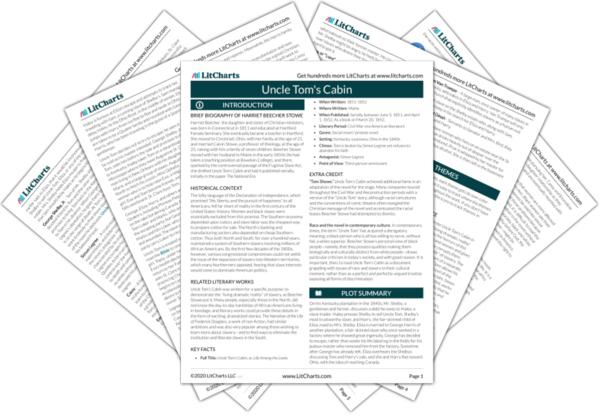Summary
Analysis
La Belle Riviere continues down the Mississippi. Tom’s conduct has convinced Haley he is trustworthy; Tom is therefore allowed to sleep without fetters and to walk as he pleases around the ship. Atop cotton-bales on the ship’s deck he looks out on the plantations they pass, slaves at hard labor in the fields, and thinks back on his time in Kentucky. Beecher Stowe states that an educated person would be able to write to his family, but Tom can write only poorly and so cannot communicate with Chloe and others at home.
Tom’s difficulties reading and writing are symbolic of a greater inequality—that of opportunity between whites and blacks. Only through immense hard word is Tom able actually to read the Bible and participate fully in his Christian faith. If Tom were a free man, he could be an educated man, and his ability to read the Bible would likewise increase.
Themes
Tom takes out his Bible and reads, haltingly, “In my Father’s house there are many mansions . . . .” Although there are no notes in the margins of the Bible, Tom has marked up favorite sections from hearing George read to him.
This line, taken from the Biblical book of Matthew, has been understood many ways. One is simple: that God’s divine home will make room for all those who believe in him.
Themes
On the boat are a New Orleans gentleman named St. Clare and his five-or-six-year-old daughter, a beautiful, fair-haired, blue-eyed child, dressed always in white, whom the narrator likens to an angel. Evangeline, as she is known, walks all over the vessel and smiles at the slaves, the “firemen” who shovel coal, and others. She meets Uncle Tom, takes an immediate liking to him, and offers that her father might buy him. At a boat-landing Eva accidentally falls in the water, and Tom dives in after her, saving her with little trouble.
St. Clare is introduced, as is his daughter Eva. Eva’s relationship with Tom will become an important one in the book, as both are characters of great religious feeling, and both are willing to die for the betterment and protection of others.
Themes
The next day, St. Clare does in fact offer to buy Tom from Haley. Haley sets the price at $1300. St. Clare jokes that Tom’s Christianity, intelligence, and trustworthiness might cause trouble and should result in a lower price. In truth, however, St. Clare recognizes Tom’s kindness and Eva’s apparent love for him. St. Clare introduces himself to Tom and promises to make him coachman at his New Orleans estate. Eva tells Tom that her father is a benevolent slave-owner, and that his teaching hides a real concern for his slaves.
Get the entire Uncle Tom's Cabin LitChart as a printable PDF.













